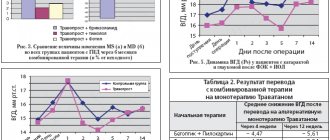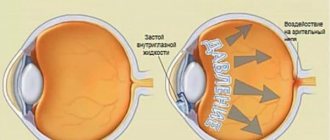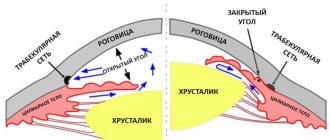Anesthetic eye drops
This type of eye medication blocks nerve impulses for a certain period of time. This group contains several eye drops (Inocaine, Lidocaine, Alcaine). The effect of the anesthetic begins within 1-2 minutes and lasts about 15-20 minutes.
Indications for the use of these drops are:
- Manipulations to remove a foreign object from the eye.
- Carrying out diagnostic procedures (contact tonometry, gonioscopy, Schirmer test).
- First aid for eye injuries.
- During ophthalmic operations as a local anesthetic.
Inocaine 0.4% 5 ml eye drops.
Instructions for medical use of the drug Inocaine Trade name Inocaine International nonproprietary name Oxybuprocaine Dosage form Eye drops 0.4%, 5 ml Composition 1 ml of solution contains the active substance: benoxynate hydrochloride (oxybuprocaine hydrochloride) 4.0 mg, excipients: benzalkonium chloride, disodium edetate, boric acid, sodium chloride, sodium hydroxide, water for injection. Description Transparent colorless solution Pharmacotherapeutic group Preparations for the treatment of eye diseases. Local anesthetics. Oxybuprocaine Code ATX S01HA02 Pharmacological properties Pharmacokinetics Inocaine easily penetrates the corneal stroma after a single instillation into the conjunctival cavity, quickly causes superficial anesthesia, and has a slight irritant effect on the conjunctiva. Over the next 15 minutes, a quantitative decrease in the stromal concentration of the drug is observed, which causes a 12-15 minute period of anesthesia with a single instillation. The drug causes a reversible blockade of the propagation and conduction of nerve impulses through the axons of nerve cells. Pharmacodynamics Local anesthetic. Inocaine blocks nerve endings. Penetrates well into tissues when applied topically. Has a slight irritant effect on the conjunctiva and cornea. Superficial anesthesia of the conjunctiva and cornea occurs within 30 seconds and lasts 15 minutes. Indications for use Local anesthesia in ophthalmology during: - measurement of intraocular pressure (tonometry) - gonioscopy - diagnostic scraping of the conjunctiva - removal of foreign bodies and sutures from the cornea and conjunctiva - short-term surgical interventions on the cornea and conjunctiva Method of administration and dosage Inocaine is used topically. To perform tonometry, gonioscopy, and diagnostic scraping of the conjunctiva, 1 drop of the drug is instilled into the conjunctival sac. Superficial anesthesia of the conjunctiva and cornea occurs within 30 seconds and lasts up to 15 minutes. Long-term anesthesia (up to 1 hour) is provided by three instillations of Inocaine with an interval of 4-5 minutes. Side effects - tingling sensation, burning sensation, conjunctival hyperemia - minor damage to the corneal epithelium, keratopathy (toxic, necrotic ulcers, postoperative) - keratitis (toxic, superficial ulcerations of the cornea, discoid, candidal keratitis as a result of the development of superinfection) - fibrinous iritis - contact dermatitis ( allergic and non-allergic periorbital dermatitis) - decreased stability of the precorneal film (in patients with blue eyes) - changes in corneal thickness - decreased corneal sensitivity and frequency of spontaneous blinking - unintentional movements of the eyeballs systemic effect: - acute sinus bradycardia - idiosyncratic anaphylactic reaction cytotoxic effects: - direct cytotoxic effect on the cornea - cytotoxic effect on the cornea, causing a decrease in direct oxygen absorption by the corneal epithelium side effects of the preservative (benzalkonium chloride): - chemosis, angioedema, allergic reactions, individual intolerance, corneal edema, necrosis of the corneal epithelium, conjunctival necrosis, damage surface, damage to the corneal endothelium, acute band keratopathy, stromal edema, folds of Descemet's membrane, biomicroscopically enlarged endothelium, loose inclusions of the iris at the edge of the pupil, local transillumination of the iris, opacification of the posterior capsule, thickening of the central part of the cornea, decreased density of endothelial cells, extracellular melanosomes , cessation of normal cytokinesis and mitotic activity. Contraindications - hypersensitivity to the active substance or to any auxiliary components of the drug - children under 8 years of age Drug interactions Inocaine can reduce the antibacterial activity of sulfonamides and beta-blockers; it is not compatible with silver nitrate, mercury salts, alkaline solutions. Special instructions The drug is intended for instillation only into the conjunctival sac. The drug is not recommended for independent home use, because its continued, repeated and long-term use may lead to permanent corneal opacification. Inocaine is not intended for long-term therapy in the complex treatment of eye diseases. When using the drug, the development of an anaphylactic reaction and sinus bradycardia is possible. With caution: severe heart failure, allergic reactions. Do not touch the tip of the bottle to any surfaces to avoid contamination. Until the end of anesthesia, you should avoid effects on the eyes: friction, foreign bodies, irritating chemicals. Before instilling the drug, contact lenses should be removed and can be put back on after 15 minutes. Use in pediatrics There is no sufficient experience of use in children. It may be used as prescribed by a doctor if the expected therapeutic effect outweighs the risk of side effects. Pregnancy and lactation There is no sufficient experience of use during pregnancy and lactation. Features of the effect of the drug on the ability to drive a vehicle or potentially dangerous mechanisms. After application, patients temporarily lose clarity of vision; it is not recommended to drive a car or work with complex machinery, machines or any other complex equipment that requires clarity of vision immediately after instillation of the drug. Overdose Symptoms: development of side effects. Treatment: symptomatic. Release form and packaging 5 ml of the drug in plastic dropper bottles. 1 dropper bottle together with a screw cap, inside of which there is a device for opening the bottle and with instructions for medical use in the state and Russian languages, is placed in a cardboard box. Storage conditions Store at a temperature not exceeding 25 ° C, in a place protected from light. Do not freeze. Keep out of the reach of children! Shelf life: 2 years; Period of use after opening the bottle: 1 month. Do not use after the expiration date stated on the packaging. Dispensing conditions Prescription Manufacturer SENTISS PHARMA PVT. LTD., India 212/D-1, Green Park, New Delhi, India At the plant: Khera Nikhla Village, Nalagarh Tehsil, Solan District, Himachal Pradesh 174 101, India Registration Certificate Holder SENTISS PHARMA PVT. LTD., India Address of the organization that accepts claims from consumers regarding product quality on the territory of the Republic of Kazakhstan: Republic of Kazakhstan, 050000, Almaty, st. Bogenbai Batyr 132, office 309 Tel./fax Email
In what cases should you not use anesthetics?
Anesthetic eye drops should only be prescribed by an ophthalmologist. You cannot use them on your own if the cause of the pain is unknown. If used for long periods of time, the anesthetic solution can cause very serious, irreversible damage to the surface of the cornea.
In some cases, eye pain is associated with neuralgic diseases. If patients use these drops to relieve such pain, there is a high risk of developing corneal clouding and loss of visual function.
INOCAINE (drops)
where it was necessary to work in glasses and in order to get them there was no longer a person since they worked late and under certain circumstances chips got into my eyes, at first my eyes just groaned and I went to the doctor, he said that the infection was wrong and there was no need to clean it and prescribed one a medicine that did not help in the future.
When I woke up I could not open my eyes from pain. I went to a private eye doctor, he cleared my eyes, saying why didn’t you go and clear them right away and just let them go (that’s the kind of doctors we have) and prescribed medications that later helped and I will write about them in other topics. The first day I was able to open my eyes, but it was painful to instill the medicine and the next day my eyes did not open again. And I decided to go to the pharmacy, showed the salesman my eyes and said I could take some painkillers. She recommended Inacoin to me and after the first use I felt like I was born again, the pain completely disappeared, and since I was warned that this medicine works for about 20 minutes, I immediately ran to instill the drops prescribed for me. Even though it was easier for me, it only lasted for an hour, but I immediately thought that it was good that Inocaine was sold without a doctor’s prescription. And every time, before using the medicine, I buried it. In fact, my eyes were scratched as if they had been walked over with sandpaper, and the fact that before using medications that burned my eyes and increased the pain even more, I was pleased with the opportunity to relieve the pain, although not for long.
To be honest, at that time I didn’t care whether Inocaine had any effect on vision or anything like that. But after the treatment, I inquired and it turned out that Inocaine is a type of anesthetic that blocks nerve endings and that, compared to other anesthetics, has less irritation on the cornea of the eye. And that this medicine, if taken strictly according to the instructions, will not affect your vision and eyes. And also that negative effects can only occur if a person has a hypersensitivity to this type of medication. But frequent use is not recommended 1-2 times a day.
Personally, my attitude towards this type of anesthetic is beyond praise because even if it doesn’t relieve pain for a long time, it is possible to drop in the necessary drops, and even more so if you need to apply a special ointment for the eye where you don’t just need to drip, bend the eyelid and coat it, which also happens much more painful. I also took it for only 138 rubles, but in general we can say that it was 140 rubles, you’ll agree that it’s not a big amount.
So I recommend this anesthetic because it does not negatively affect the eyes and it actually helped me a lot.
Non-steroidal anti-inflammatory drops
Nonsteroidal drugs have both analgesic and anti-inflammatory effects. The mechanism of their action is associated with inhibition of the synthesis of substances that support inflammation and pain. In this regard, their effectiveness does not appear immediately, but after some time after the start of use.
Indications for the use of non-steroidal analgesic drops are:
- Abdominal surgery on the eyeball
- Elimination of pain after laser vision correction.
- Inflammatory eye diseases (iridocyclitis, scleritis, etc.).
Inocaine 0.4% 5ml eye drops
pharmachologic effect
Local anesthetic.
Composition and release form Inocaine 0.4% 5ml eye drops
Drops - 1 ml:
- active substance: benoxynate hydrochloride (oxybuprocaine hydrochloride) 4 mg;
- excipients: benzalkonium chloride 0.1 mg, boric acid 19.0 mg, disodium edetate 0.1 mg, sodium chloride 8.0 mg, water for injection up to 1 ml.
5 ml in a plastic dropper bottle with a screw cap. Each dropper bottle, along with instructions for use, is placed in a cardboard box.
5 ml in a dark glass bottle, closed with a rubber stopper, crimped with an aluminum cap with a safety plastic cap. One glass bottle with a sterile dropper, packed in a plastic bag, is placed in a cardboard box along with instructions for use.
Description of the dosage form
Transparent colorless solution.
Directions for use and doses
Locally, 1 drop is instilled into the conjunctival sac.
Long-term anesthesia (up to 1 hour) is provided by 3-fold instillation with an interval of 4-5 minutes.
Pharmacodynamics
Local anesthetic; blocks nerve endings. Penetrates well into tissues when administered locally. Compared to tetracaine and other local anesthetics, it has less irritating effect on the conjunctiva and cornea.
Superficial anesthesia of the conjunctiva and cornea occurs within 30 seconds and lasts 15 minutes.
Pharmacokinetics
Inocaine® easily penetrates the corneal stroma after a single instillation into the conjunctival cavity. Over the next 15 minutes, a quantitative decrease in the stromal concentration of the drug is observed, which causes a 12-15 minute period of anesthesia with a single instillation.
Indications for use Inocaine 0.4% 5ml eye drops
Local anesthesia in ophthalmology:
- measurement of intraocular pressure (tonometry);
- gonioscopy;
- diagnostic scraping of the conjunctiva;
- removal of foreign bodies and sutures from the cornea and conjunctiva;
- short-term surgical interventions on the cornea and conjunctiva.
Contraindications
Individual hypersensitivity to the components of the drug.
Use of Inocaine 0.4% 5ml eye drops during pregnancy and breastfeeding
There is no sufficient experience with the use of the drug during pregnancy, breastfeeding and in children. It is possible to use Inocaine ® for the treatment of children, pregnant and nursing mothers as prescribed by the attending physician, if the expected therapeutic effect exceeds the risk of developing possible side effects.
special instructions
Use only for instillation into the conjunctival sac. Do not use for injection.
Prolonged, repeated and long-term use (as with other local anesthetics) can lead to permanent opacification of the cornea.
Not intended for long-term therapy in the complex treatment of eye diseases.
During anesthesia, it is necessary to protect the eye from irritating chemicals, foreign bodies and friction.
Overdose
There are no data on drug overdose.
Side effects Inocaine 0.4% 5ml eye drops
Short-term tingling sensation, burning and hyperemia of the conjunctiva; allergic reactions; keratitis (rare).
Drug interactions
The literature does not describe negative or positive effects when oxybuprocaine and other traditionally used eye drops are simultaneously administered into the conjunctival cavity.
It is noted that oxybuprocaine can theoretically reduce the antibacterial activity of sulfonamides.




